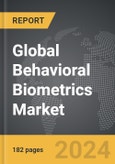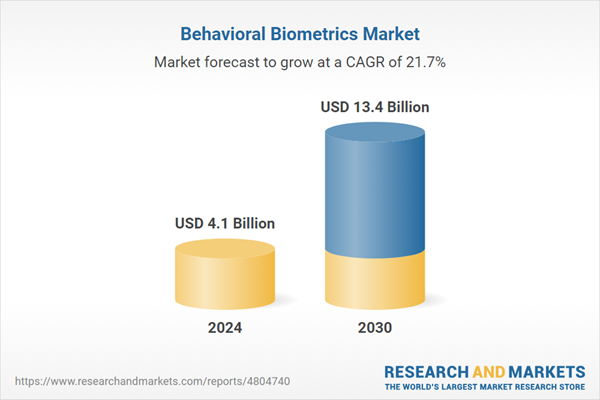The global market for Behavioral Biometrics was estimated at US$4.1 Billion in 2024 and is projected to reach US$13.4 Billion by 2030, growing at a CAGR of 21.7% from 2024 to 2030. This comprehensive report provides an in-depth analysis of market trends, drivers, and forecasts, helping you make informed business decisions. The report includes the most recent global tariff developments and how they impact the Behavioral Biometrics market.
Global Behavioral Biometrics Market - Key Trends and Drivers Summarized
How Are Behavioral Biometrics Transforming Security and User Authentication?
Behavioral biometrics refers to the identification and authentication of individuals based on their unique patterns of behavior, such as how they type, swipe on a touchscreen, move a mouse, or even how they walk. Unlike traditional biometric methods that rely on physical characteristics like fingerprints or facial recognition, behavioral biometrics focus on the subtle and often subconscious actions that are difficult to mimic or replicate. This technology continuously monitors and analyzes user behavior, creating a unique behavioral profile that can be used to verify identity. When a deviation from this profile is detected, it can trigger alerts or additional authentication steps, thereby enhancing security. Behavioral biometrics are increasingly being integrated into security systems and user authentication processes across various industries, offering a more dynamic and continuous method of securing digital environments against unauthorized access.How Are Technological Advancements Enhancing Behavioral Biometrics?
Technological advancements are playing a critical role in enhancing the capabilities of behavioral biometrics, making them more accurate, efficient, and scalable. One significant development is the use of machine learning and artificial intelligence (AI) to analyze vast amounts of behavioral data in real time. These technologies enable systems to learn and adapt to subtle changes in user behavior, improving the accuracy of authentication and reducing the likelihood of false positives or negatives. Additionally, advancements in data collection and processing power have made it possible to analyze complex behavioral patterns quickly and with greater precision, even in large-scale applications. The integration of behavioral biometrics with other security measures, such as multi-factor authentication (MFA), is also gaining traction, providing an additional layer of protection without compromising user convenience. As these technologies continue to evolve, behavioral biometrics are becoming a more robust and reliable solution for enhancing digital security.Why Is the Demand for Behavioral Biometrics Growing Across Industries?
The demand for behavioral biometrics is rapidly increasing across various industries due to the rising need for enhanced security measures in an increasingly digital world. Financial institutions, for example, are adopting behavioral biometrics to protect against fraud and identity theft by ensuring that only legitimate users can access sensitive accounts and perform transactions. The healthcare sector is also embracing this technology to secure patient data and ensure that only authorized personnel have access to electronic health records. In the enterprise space, companies are using behavioral biometrics to safeguard against insider threats and ensure the security of their IT infrastructure. Moreover, the growing reliance on remote work and digital platforms has heightened the need for continuous and unobtrusive authentication methods, making behavioral biometrics an attractive solution. As cyber threats become more sophisticated, the ability to continuously monitor and verify user identity through behavioral patterns is becoming increasingly valuable, driving demand for this technology across multiple sectors.What Forces Are Propelling the Expansion of the Behavioral Biometrics Market?
The growth in the behavioral biometrics market is propelled by several key forces, including the increasing sophistication of cyber threats, which drives the need for advanced and continuous authentication methods. The widespread adoption of digital banking, online services, and remote work environments is further fueling demand, as these platforms require robust security to protect sensitive information. Technological advancements in AI and machine learning are also playing a significant role, enhancing the accuracy and scalability of behavioral biometrics solutions. Moreover, rising regulatory pressures and the need to comply with stringent data protection standards are encouraging organizations to integrate behavioral biometrics into their security frameworks. The surge in identity theft and fraud incidents, combined with the limitations of traditional authentication methods, is prompting industries to turn to behavioral biometrics as a more secure alternative. As these trends continue to develop, the market for behavioral biometrics is set for substantial growth, driven by ongoing innovation and the escalating demand for sophisticated digital security solutions.SCOPE OF STUDY:
The report analyzes the Behavioral Biometrics market in terms of units by the following Segments, and Geographic Regions/Countries:- Segments: Component (Software, Services); Application (Identity Proofing, Continuous Authentication, Risk & Compliance Management, Fraud Detection & Prevention management); End-Use (BFSI, IT & Telecom, Healthcare, Retail & eCommerce, Other End-Uses)
- Geographic Regions/Countries: World; United States; Canada; Japan; China; Europe (France; Germany; Italy; United Kingdom; and Rest of Europe); Asia-Pacific; Rest of World.
Key Insights:
- Market Growth: Understand the significant growth trajectory of the Identity Proofing segment, which is expected to reach US$6.9 Billion by 2030 with a CAGR of a 24.7%. The Continuous Authentication segment is also set to grow at 17.9% CAGR over the analysis period.
- Regional Analysis: Gain insights into the U.S. market, valued at $1.2 Billion in 2024, and China, forecasted to grow at an impressive 20.8% CAGR to reach $2.0 Billion by 2030. Discover growth trends in other key regions, including Japan, Canada, Germany, and the Asia-Pacific.
Why You Should Buy This Report:
- Detailed Market Analysis: Access a thorough analysis of the Global Behavioral Biometrics Market, covering all major geographic regions and market segments.
- Competitive Insights: Get an overview of the competitive landscape, including the market presence of major players across different geographies.
- Future Trends and Drivers: Understand the key trends and drivers shaping the future of the Global Behavioral Biometrics Market.
- Actionable Insights: Benefit from actionable insights that can help you identify new revenue opportunities and make strategic business decisions.
Key Questions Answered:
- How is the Global Behavioral Biometrics Market expected to evolve by 2030?
- What are the main drivers and restraints affecting the market?
- Which market segments will grow the most over the forecast period?
- How will market shares for different regions and segments change by 2030?
- Who are the leading players in the market, and what are their prospects?
Report Features:
- Comprehensive Market Data: Independent analysis of annual sales and market forecasts in US$ Million from 2024 to 2030.
- In-Depth Regional Analysis: Detailed insights into key markets, including the U.S., China, Japan, Canada, Europe, Asia-Pacific, Latin America, Middle East, and Africa.
- Company Profiles: Coverage of players such as Affectiva, BI² Technologies, Biocatch Ltd., Callsign Inc., IBM Corporation and more.
- Complimentary Updates: Receive free report updates for one year to keep you informed of the latest market developments.
Some of the 18 companies featured in this Behavioral Biometrics market report include:
- Affectiva
- BI² Technologies
- Biocatch Ltd.
- Callsign Inc.
- IBM Corporation
- ID R&D
- id3 Technologies
- LexisNexis Risk Solutions Group
- NuData Security Inc.
- One Identity LLC.
This edition integrates the latest global trade and economic shifts as of June 2025 into comprehensive market analysis. Key updates include:
- Tariff and Trade Impact: Insights into global tariff negotiations across 180+ countries, with analysis of supply chain turbulence, sourcing disruptions, and geographic realignment. Special focus on 2025 as a pivotal year for trade tensions, including updated perspectives on the Trump-era tariffs.
- Adjusted Forecasts and Analytics: Revised global and regional market forecasts through 2030, incorporating tariff effects, economic uncertainty, and structural changes in globalization. Includes segmentation by product, technology, type, material, distribution channel, application, and end-use, with historical analysis since 2015.
- Strategic Market Dynamics: Evaluation of revised market prospects, regional outlooks, and key economic indicators such as population and urbanization trends.
- Innovation & Technology Trends: Latest developments in product and process innovation, emerging technologies, and key industry drivers shaping the competitive landscape.
- Competitive Intelligence: Updated global market share estimates for 2025, competitive positioning of major players (Strong/Active/Niche/Trivial), and refined focus on leading global brands and core players.
- Expert Insight & Commentary: Strategic analysis from economists, trade experts, and domain specialists to contextualize market shifts and identify emerging opportunities.
- Complimentary Update: Buyers receive a free July 2025 update with finalized tariff impacts, new trade agreement effects, revised projections, and expanded country-level coverage.
Table of Contents
I. METHODOLOGYII. EXECUTIVE SUMMARY2. FOCUS ON SELECT PLAYERSIII. MARKET ANALYSISCANADAITALYREST OF EUROPEREST OF WORLDIV. COMPETITION
1. MARKET OVERVIEW
3. MARKET TRENDS & DRIVERS
4. GLOBAL MARKET PERSPECTIVE
UNITED STATES
JAPAN
CHINA
EUROPE
FRANCE
GERMANY
UNITED KINGDOM
ASIA-PACIFIC
Companies Mentioned (Partial List)
A selection of companies mentioned in this report includes, but is not limited to:
- Affectiva
- BI² Technologies
- Biocatch Ltd.
- Callsign Inc.
- IBM Corporation
- ID R&D
- id3 Technologies
- LexisNexis Risk Solutions Group
- NuData Security Inc.
- One Identity LLC.
Table Information
| Report Attribute | Details |
|---|---|
| No. of Pages | 182 |
| Published | July 2025 |
| Forecast Period | 2024 - 2030 |
| Estimated Market Value ( USD | $ 4.1 Billion |
| Forecasted Market Value ( USD | $ 13.4 Billion |
| Compound Annual Growth Rate | 21.7% |
| Regions Covered | Global |









